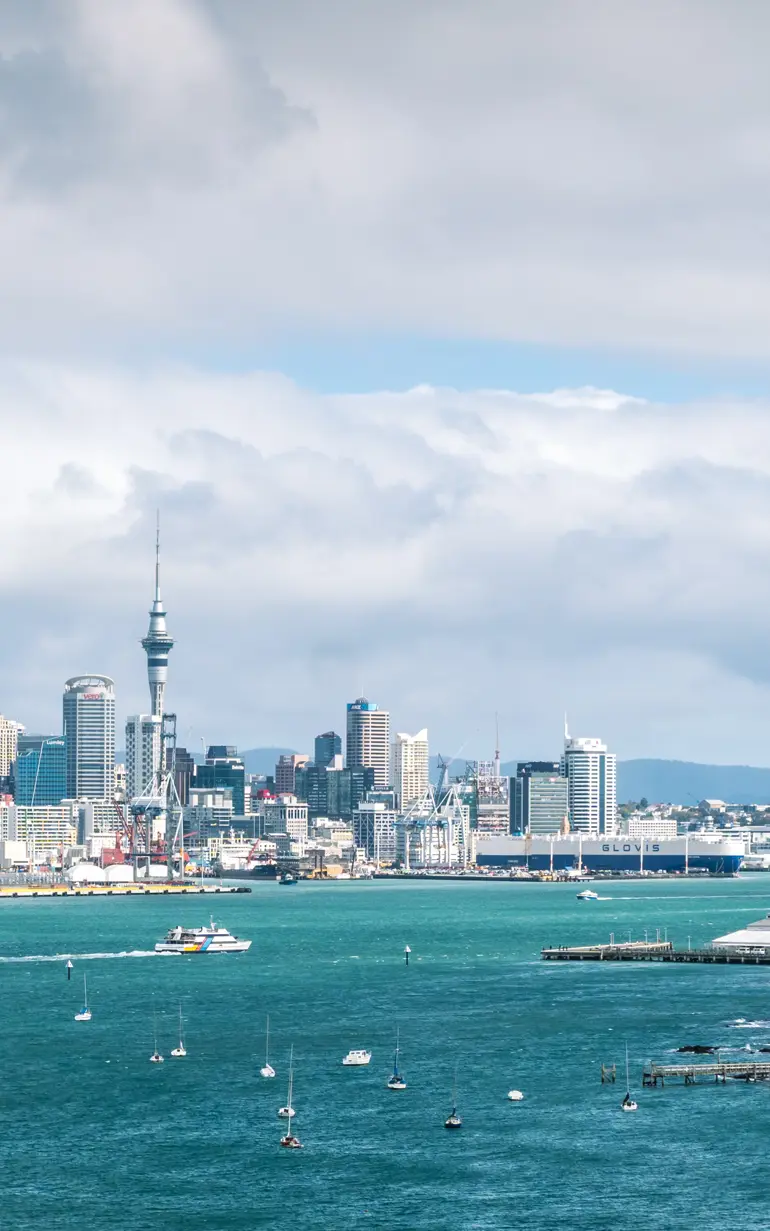
Healthy harbours in Auckland
Restoring the city’s coastal water quality with an innovative solution
Auckland is the largest city in New Zealand with the most densely populated coast in the country. The ‘City of Sails’ has globally iconic coastlines ranging from sandy beaches and dunes, rocky shores and cliffs, estuaries and offshore islands to three major harbours – and its beautiful coasts are the city’s prized attractions to residents and visitors. Auckland is facing a series of major challenges, including rapid growth, against a backdrop of declining coastal water quality affecting every Aucklander. Biodiversity, cultural values, fisheries and broader ecosystem services are at risk of degradation while simultaneously benefiting from investment as Auckland grows. Targeted growth and investment in water are central to improving quality of life, reducing costs of living and delivering on the country’s unique commitment to its people – Te Tiriti o Waitangi.
Challenge
Auckland Council’s Healthy Waters department knows the challenges ahead of the city as 300,000 more people are predicted to settle in the region by early 2030s. What effects will the increasing population have on Auckland’s waterways? Will that change as the population grows and as climate varies? What can Auckland Council do to manage this? Simply, how does Auckland improve its water quality?
To better manage water quality and enable smarter growth, Auckland Council has developed an innovative Freshwater Management Tool (FWMT). Using US-EPA open-sourced models, the FWMT predicts water quality and flows in every one of the region’s catchments, before identifying least-cost actions to improving waterways.
The FWMT enables Auckland Council to forecast and identify ongoing degradation from growth and land use, including corresponding causes. The FWMT then tests hundreds of thousands of feasible options targeted at critical sources to determine least-cost strategies to improve flows or reduce nutrients, heavy metals, sediment and bacteria in waterways.
The FWMT operates from mountains to sea but does not simulate outcomes in estuaries or harbours, creating uncertainty about ongoing and future effects on Auckland’s coast. So, making growth more challenging and increasing risks for poorly targeted investment and degraded harbours.
Solution
Combining DHI’s Coastal Receiving Environment Scenario Tool with Auckland Council’s Freshwater Management Tool
DHI’s team in New Zealand and Auckland Council’s Healthy Waters department carried out a contaminant assessment of the inner and outer Waitematā Harbour using a coupled FWMT-coastal hydrodynamic model. Continuous time series for 80 sub-catchments were fed to a wave and tide-forced hydrodynamic model to predict the transport and fate of stormwater contaminants, including Total Nitrogen (TN), Total Phosphorus (TP), Total Suspended Solids (TSS), Total Copper (TCu) and Total Zinc (TZn).
A catchment-to-coast connectivity matrix was developed between FWMT inflows and sub-domains within the model domain. With this approach, Auckland Council could estimate the contribution of freshwater-derived contaminants to the coastal receiving environment at close to 100 sub-estuary/harbour domains within the inner and outer Waitematā Harbour.
Based on the connectivity matrix, an online Coastal Receiving Environment Scenario Tool (CREST) system was developed to allow Auckland Council to view the baseline model results and compare them against agreed thresholds for each contaminant. The tool can then evaluate whether load reductions in the catchments would translate to improved coastal water quality.
The solution allows Auckland Council to independently view the link between source and sink, run cost-effective what-if scenarios and access the data 24/7 globally through a digital portal. With its user-friendly interface, the solution facilitates collaboration and stakeholder engagement anytime and anywhere.
Results
With a holistic understanding of how contaminants affect both fresh and coastal waterways, Auckland Council can now do more to advise, support and incentivise actions to improve water quality in an efficient, targeted and evidence-based way. Previous approaches have focused on meeting contaminant targets within freshwater – and this integrated approach sheds light on whether meeting these targets will improve the ecological health of estuaries and harbours, or if more investment will be needed.
The solution facilitates informed decision-making and supports Auckland Council in identifying hot spots of ecological importance such as seagrass beds or shellfish beds as well as catchments which contribute to the poorest water quality. This knowledge can help them pinpoint where to focus resources to reduce contaminant loads, protect marine biodiversity and ensure sustainable future development of the catchments.
- This solution helps inform if reductions in contaminants in catchments will improve coastal ecosystem health
- It provides the first steps for developing a regionwide fully integrated catchment-to-sea land use management tool
- Auckland Council has a better idea of where best to focus investment for land use change and mitigation
Client:
Location:
New Zealand
Related SDG(s):
SDG 6: Ensuring access to water and sanitation for all
SDG 11: Make cities and human settlements inclusive, safe, resilient and sustainable
SDG 14: Conserve and sustainably use the oceans, seas and marine resources for sustainable development
Technology:
DHI’s Coastal Receiving Environment Scenario Tool
Auckland Council’s Freshwater Management Tool
‘The Freshwater Management Tool (FWMT) is a game changer for freshwater quality in Auckland. Without better coastal understanding, the FWMT is unable to assure us that investment is targeted at the best solutions for our prized harbours. Integrating the FWMT with DHI’s hydrodynamic coastal model was a natural solution, building on an already award-winning approach*. The outcome is better support for development and rural production, lower-cost to Aucklanders and more transparent evidence for decision-makers.’
Dr. Theodore Kpodonu
Healthy Waters – Auckland Council
About our client
Auckland Council is the local authority responsible for local government functions in the Auckland region (population of around two million). New Zealand has varied types of local authorities – Auckland Council combines city and regional government into a unitary authority. Healthy Waters is the department leading and responsible for decision-making on how to manage effects in fresh and coastal waterways. Nick Brown (Manager – Regional Planning) established the Freshwater Management Tool programme to serve Auckland Council, Council Controlled Organisations (wastewater, roading), mana whenua (indigenous peoples of New Zealand) and broader stakeholders affected by resource use decisions.
*DHI and Healthy Waters (Auckland Council) have previously won a Global Water Award for Safeswim, a recreational risk alert programme based on hydrodynamic coastal modelling. Learn more.
You may also like
How can we help?
With our global network of offices, we make sure you get the right answers to your local needs. Tell us about your water challenges and we will get back to you.


